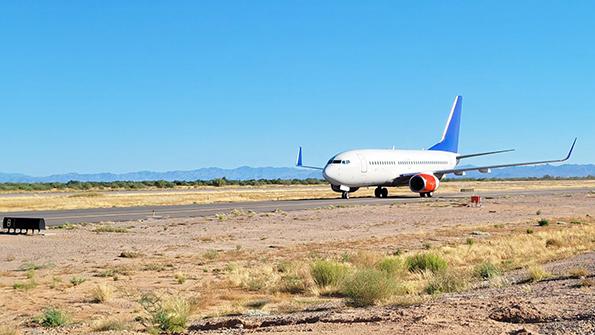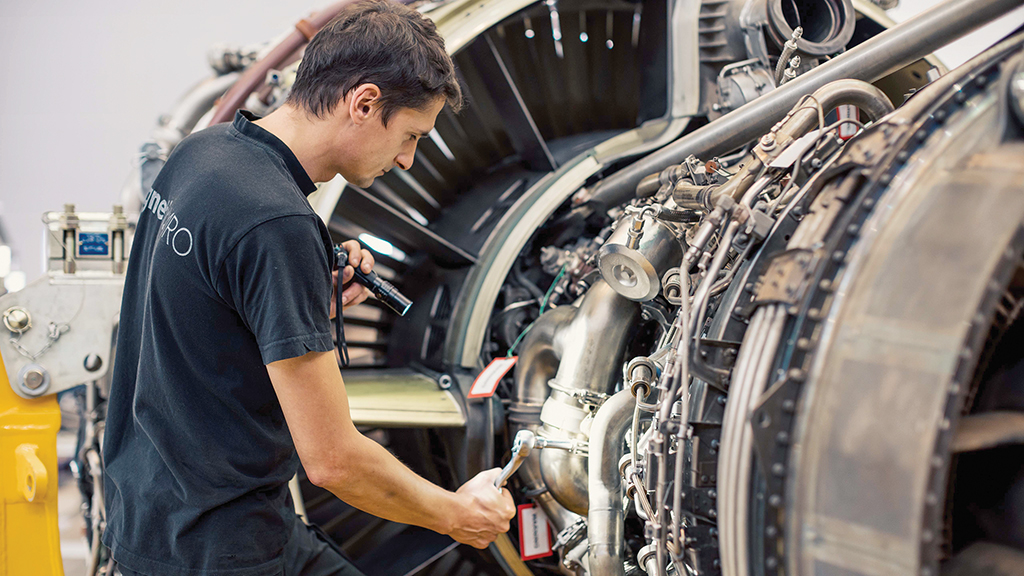Supply, Workforce Issues Linger In Europe’s Aftermarket

The anticipated wave of post-COVID-19 aircraft retirements has yet to materialize in Europe.
After the height of the COVID-19 pandemic, MRO industry observers expected that the subsequent years would result in an increased level of aircraft retirements and a wave of airline bankruptcies leading to high volumes of aircraft being torn down. At the end of 2022, nearly three years since the start of the pandemic, this scenario has yet to materialize, with carriers opting to extend the lives of their assets and only a relatively small number of carriers entering bankruptcy. These factors, along with OEM supply chain constraints, mean that demand for used serviceable material (USM) remains strong, with price escalation being seen in most parts of the world.
Lee McConnellogue, CEO at UK-based aircraft disassembly and part-out specialist Ecube, notes that instead of the wave of retirements predicted at the start of the pandemic, a reverse scenario has actually occurred, with the prediction of a “staggeringly low number” of part-outs predicted for the third quarter of 2022. “Looking at the past 18 months, I’d say we’re at historic lows on part-outs, and there’s varying reasons for that, not least of all indecision,” he says.
McConnellogue says the company, headquartered in St. Athan, Wales, is seeing some signs of recovery, albeit sluggish. He attributes this to multiple causes including financially driven decisions around retirements and the inability to replace aircraft by having new ones delivered from OEMs beset by production backlogs. “Some operators just want to play a waiting game and see what they can realize out of the asset later on,” he says.
McConnellogue finds that the constrained environment makes it a good time to be a teardown specialist. “We’re seeing an increased demand for USM,” he says. “We’re also seeing older aircraft stay in service longer with a great parts requirement, so for us, while USM is not our core business, it is a key value driver within our business.”
Adrian Plevin, senior vice president for strategy, sales and marketing at Meggitt, describes the USM segment as effectively a headwind for certain products. The company, which was acquired by U.S.-based OEM Parker Aerospace in September, is looking to address any USM market uncertainties by becoming more active in the segment from its centers of excellence, located in Miami, Singapore and at its Coventry, England, home base.
“We’re trying to set up USM capability and have a team of people in place who are supporting the USM market,” he says. Plevin acknowledges that issues around the supply chain, a result of multiple global factors, will not start to normalize until next year, but he says availability of Meggitt’s own parts has presented challenges. “Our experience certainly over the past two years, and maybe even a year or so pre-COVID-19, was there wasn’t a great deal of availability, but that is now starting to pick up,” he notes.
Lee Carey, vice president for asset management at Dublin-headquartered end-of-life asset management company EirTrade, whose primary business is parts trading, says there are decisions to be made about the future of many assets still in the market. “We’ve seen a lot of [Airbus] A319 and A320 aircraft that we expected to be retired this year have their leases extended for another 2-3 years,” he says. “There are going to be issues around new aircraft deliveries, and that’s going to extend the life of some of those assets as well.”
Workforce Challenges
The MRO industry’s growing workforce shortage was top of mind for many companies attending MRO Europe. Now that demand for maintenance has returned, a shortage of labor is limiting how much work can be accomplished—which has a knock-on effect for companies such as lessors, cargo carriers and smaller airlines that are already struggling to find maintenance slots.
While many efforts are underway to introduce young people to MRO careers, positions of technicians who left the industry during the pandemic still need to be filled. Robert Murphy, head of training for maintenance and engineering at Aer Lingus, says “the elephant in the room” is the cost of being able to compete with salaries in other sectors. He says this is being exacerbated by inflation’s impact on cost of living, particularly in Europe.

“If you’re a [technician] who . . . is faced with the option of getting a mortgage on an aircraft engineer’s pay or going to one of the pharmaceutical companies and maybe getting the extra few bits and pieces that will actually put you over the line in terms of even simple things like health insurance and all those other things that they offer as a matter of course—those industries are hard to compete with,” he says.
Increasing salaries also mean increasing costs, which will need to be passed on to customers. Some European MROs are trying to tackle the issue by recruiting technicians from abroad. FL Technics CEO Zilvinas Lapinskas says the company has been forced to look for labor in countries such as India and Pakistan, since it is difficult to fill technician positions in Europe.
Even if MROs are able to raise salaries, finding qualified talent has been difficult for some. “There is a huge gap with what universities are doing and what businesses need,” says Krzystof Krolak, vice president of technical operations at LOT Polish Airlines. “My issue, working for an airline, is finding people with not only an engineering background but also aviation skills. It’s a huge problem. Today, when you go to universities, either you find a mechanic—B1 or B2—or you find a design engineer. There is nothing in between.”
Krolak emphasizes that it is important for companies to work directly with universities to communicate their needs and help shape MRO-related curriculum.
The time and effort required to obtain maintenance certifications is also a challenge for MROs trying to entice new workers. “In aviation, the career takes quite a long time to build up,” says Ene Krinpus, chief human resources officer at Magnetic MRO. “Nowadays, if you say to the younger generation that it takes 5-6 years for you to become a licensed engineer, they think that’s too long.” She adds that this time commitment could also discourage people who might otherwise be considering a career change to the aviation industry.
Krinpus says it is crucial for MROs to demonstrate a clear growth path within the industry and provide support to new workers through initiatives such as mentorships. Aer Lingus’ Murphy also argues that the industry should devote effort to changing perceptions about the prestige of a maintenance certification.
“In Germany and the Nordic countries, there is no parity-of-esteem issue, but in Ireland, as a mechanic, you’re not seen the same as a college graduate,” Murphy says, despite the fact that an airframe and powerplant technician certification requires a significant time commitment and high scores on examinations. He argues that a maintenance certification should be considered equivalent to a bachelor’s or master’s degree when a student reaches certain levels. “I think there’s a challenge for the industry to work with the universities to actually bridge that gap,” he says.
Engine MRO Networks
Having experienced technical difficulties in entering engines into service, the next great challenge for OEMs and their new-generation engine families is expected to lie in meeting production ramp-ups in line with demand from airframe manufacturers. Another problem of which the industry has become more conscious in the past year is whether OEMs have the required levels of aftermarket support in place to meet demand on engine types, particularly on narrowbody variants such as the Leap and the Pratt & Whitney PW1000G geared turbofan (GTF) family.
Certifying engine MRO providers is seen as one way of steadying the ship, and at MRO Europe, two of the continent’s biggest aftermarket specialists announced new approvals to accommodate next-generation engine models. Following the announcement of GTF approvals earlier this year, Swiss MRO SR Technics announced plans to hold full maintenance capability eventually for the Leap 1B, the engine for the Boeing 737 MAX. Jean-Marc Lenz, CEO of SR Technics, told Aviation Week at MRO Europe that this service offering would be gradually built up over the next 3-5 years.
“First, we will start with lines for hospital shop and quick-turn maintenance,” he says. “We will then grow the business for this program and add more capacity over the next couple of years. Eventually, this will mean a full overhaul and performance restoration of the Leap 1B.” Lenz adds that this also will be rolled out at some point for Leap 1A engines, one of the engine options for the Airbus A320neo.
Also ramping up for new-generation engine models is Iberia Maintenance, the MRO business of the Spanish flag carrier Iberia Airlines. At MRO Europe, it announced plans to introduce services for the PW1100G variant, another powerplant option to the Leap 1A for the A320neo. The maintenance company will receive its first engine next year at its shop in Madrid. Services initially will focus on lighter engine repairs such as hospital shop visits before ramping up to full overhaul capability in several years’ time.
The move into PW1100G services reflects previous capability additions for Leap 1A and 1B engines. SR Technics and Iberia Maintenance join other European MRO providers such as MTU Aero Engines, two Lufthansa Technik facilities in Germany, EME Aero in Poland and OGMA in Portugal as part of the GTF network.






